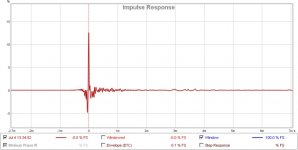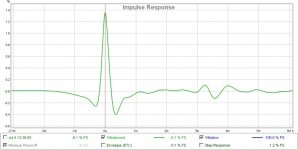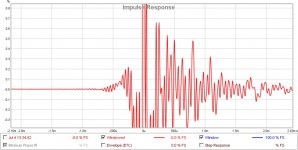W22 HP is 60Hz LR4, LP is 300Hz LR4I am not entirely sure what your targeted crossover point for the woofers low
Yes.The woofers are sealed right? And crossover to the sub woofer using active filtering.
Thanks for clearly describing this scheme.
I am using rePhase and it uses a similar approach to your suggestion.
I use raw farfield and nearfield measurements of the drivers in the speaker.
Rephase has LT transforms which along with other EQ filters are used to flatten out the measured driver response first. I then apply text book target filters.
Thanks for that. I was looking for something like the one on the right if m is for msec. It will not show the problem at -0.5 sec but will hopefully show if there is a click to chirp issue.
Andy, let me plot the impulse responses in that format and post here.
Think we think in two different scenarios here : )
Yours seems to use full ranger in Lxmini-way as single mid/tweet to replace both W15CY and T25CF001 and therefor you plan place it into tweeter enclosure.
My thought was only to replace W15CY with a driver that seems also can fulfill low frq corner (LR4 300Hz or higher) as seen into plot at post 423 but have break up nastiest much higher than W15CY so XO to tweeter can be tested higher in frq as talked about. Pointed to TC9FD because of its fantastic low cost and if relieved by a tweeter in 3-7kHz area think it will perform as fine as much more expensive 10F/8424, also member Barleywater show very impressive data with TC9FD (in a Lxmini build) here in diyA domain, and thought for mounting was same enclosure as W15CY and make adaptor with outer diameter as W15CY and mount TC9 inside this adaptor and if possible maybe offset it little bit downward closer to tweeter.
Ah, i see. Nice plan BYRTT. thanks.
I am not at all worried about that W15 cone resonance with dsp/eq and LR4 at 3,5kHz. But give it a try!
SEAS 5INCH
Juhazi, as i posted above. I did tryout a 3KHz XO with LR8. After a few days of listening, i am convinced i much prefer this over 2KHz.
the sound is indeed smoother, the tweeter seems relieved and in good recordings seems to produce some very pleasant high notes.
harshness perceived with 2KHz LR4 is absent.
When i find some time, i am going to take measurements to see the distortion with the new XO settings.
Also need to perform measurements to fine tune driver delay settings.
Also need to perform measurements to fine tune driver delay settings.
Nice! This manouvarability is the best feature with dsp. W15 shuold be pretty nice and articulate, try also lr4 I like it more than lr8, directivity is more uniform.
Andy, let me plot the impulse responses in that format and post here.
Here it is.
I think i see some ringing in the tweeter impulse response with its 2KHz LR4 HP filter enabled.
Please comment.
Attachments
The pre-ringing at the sampling frequency is at a frequency that will be inaudible (if I have understood the scales correctly). It is pre-ringing around the crossover frequency that would cause problems because it will be audible given the tweeter and midranges outputs cannot cancel everywhere (assuming that cancelling is what the filtering is seeking). There seems to be only about one period of this which I doubt will be an issue.Here it is.
I think i see some ringing in the tweeter impulse response with its 2KHz LR4 HP filter enabled.
Please comment.
So that leaves the movement at 0.5 seconds before the impulse. If it is real then you will hear it as a quieter pre-echo if you play a short transient sound like a click. It may be clearer if you listen close to the tweeter or midrange or well off-axis given it might be arranged for the tweeter and midrange sound to cancel on axis. If you can hear the pre-echo then this will be audibly degrading music and we will need to find the cause and fix it.
The pre-ringing at the sampling frequency is at a frequency that will be inaudible (if I have understood the scales correctly). It is pre-ringing around the crossover frequency that would cause problems because it will be audible given the tweeter and midranges outputs cannot cancel everywhere (assuming that cancelling is what the filtering is seeking). There seems to be only about one period of this which I doubt will be an issue.
So that leaves the movement at 0.5 seconds before the impulse. If it is real then you will hear it as a quieter pre-echo if you play a short transient sound like a click. It may be clearer if you listen close to the tweeter or midrange or well off-axis given it might be arranged for the tweeter and midrange sound to cancel on axis. If you can hear the pre-echo then this will be audibly degrading music and we will need to find the cause and fix it.
Andy can you clarify what points to movement 0.5 seconds before impulse? The ringing appears to be IN -1.0 ms range.
The pre-ringing in post 447 does not look a problem. The pre-echo in post 429 is a problem if it is real (not an artifact of the measurements or whatever that plot is). The simplest way to check if it is real is to play a click, a very short transient sound, and have a listen for a quiet pre-echo of it. If you hear that pre-echo then that is very likely the source of the loss of clarity you have been reporting. It should be straightforward to find the cause and fix it.Andy can you clarify what points to movement 0.5 seconds before impulse? The ringing appears to be IN -1.0 ms range.
Any impulsive sound that lasts only a short time is fine. It doesn't matter what it sounds like because the OP is only listening for a quiet echo of something related to it before it arrives.Where can I find a click to play and how do I know how it should sound like?
When I was messing about with acoustic cameras a few years ago we used a small plastic clicker during setup. It was probably one for dog training and cost a couple of Euros. An alternative might be to use some software to generate a small file with an impulse.
Per the REW/Help/Impulse information found Here, that first leading spike in the Impulse chart (when in the dBFS mode) is a result of the 2nd harmonic distortion. The more friendly way to see and interpret this with the distortion chart where we can see the second harmonic distortion plotted by frequency. All speaker measurements will show some level of peaks in this view of the Impulse chart when in the dBFS mode. The help within REW also covers this and there it is presented in a slightly different way.
Last edited:
Thanks that is helpful. That would make the pre-echo an artifact of the measurements/plotting and so it should not be in the FIR coefficients or be audible as a pre-echo. Still hunting for what is causing the lack of clarity and, possibly related, the higher than expected level of measured distortion in the tweeter.Per the REW/Help/Impulse information found Here, that first leading spike in the Impulse chart (when in the dBFS mode) is a result of the 2nd harmonic distortion.
havent been able to get enough time to investigate.
But i did notice the early pulses even on the bare driver IR measurements, so wasnt due to the filters.
Thanks jtalden for the pointer.
Andy,
The previous Motu DAC was causing fairly large dc-offset through the DC coupled Ncore amps.
Is it possible that the tweeter and (less likely the mid) have deteriorated a bit because of that?
Any measurements to check that? In any case, as suggested earlier, the distortion limit of the measurement chain might be another cause of the elevated levels seen.
But i did notice the early pulses even on the bare driver IR measurements, so wasnt due to the filters.
Thanks jtalden for the pointer.
Andy,
The previous Motu DAC was causing fairly large dc-offset through the DC coupled Ncore amps.
Is it possible that the tweeter and (less likely the mid) have deteriorated a bit because of that?
Any measurements to check that? In any case, as suggested earlier, the distortion limit of the measurement chain might be another cause of the elevated levels seen.
A local audio enthusiast had a listen and was quite blunt in stating that the speakers were "underwhelming"
with close to $10K in top of the line components, results shouldn't be underwhelming.
But i have learnt that a good loudspeaker design and room acoustics are the biggest factors by a wide margin. DAC, AMP etc have very little influence for most ears.
with close to $10K in top of the line components, results shouldn't be underwhelming.
But i have learnt that a good loudspeaker design and room acoustics are the biggest factors by a wide margin. DAC, AMP etc have very little influence for most ears.
If i could find the time, i want to try out an alternative to rePhase to generate the all important XO and corrrection filters.
Also want to try out plain IIR filters.
Will post pictures of the room, with hopes of some comments on their potential influence
Also want to try out plain IIR filters.
Will post pictures of the room, with hopes of some comments on their potential influence
The position a driver oscillates around is usually important in maintaining low distortion. The forces from the suspension and the current/magnet are not usually linear with deflection but the nonlinearities are designed to largely cancel each other if the oscillation is about the designed resting position. If the actual resting position is moved by, for example, gravity acting on a downward facing driver the distortion will rise and xmax will be reached at a smaller deflection.The previous Motu DAC was causing fairly large dc-offset through the DC coupled Ncore amps.
Is it possible that the tweeter and (less likely the mid) have deteriorated a bit because of that?
Any measurements to check that?
So if there is an offset you can expect to measure higher distortion than the spec and the large rise in distortion when you reach xmax will occur at a lower value than the spec. It is not a problem for most DIY active speakers because a capacitor would usually be used to protect the tweeter from DC. I guess "audiophile" concerns might lead to this being omitted?
I guess "audiophile" concerns might lead to this being omitted?
I dont know or particularly care if that is an "Audiophile" dogma.
I had considered adding a cap on the tweeter and then decided against it merely to avoid that extra work. The Ncore amps have robust protection mechanisms but that may or may not prevent the tweeters from being fried when a fault occurs.
My current DAC leads to only about 8-20mv DC offsets on the driver terminals.
The earlier Motu DAC caused around 250mv. I was just wondering if few months of usage with that amount of DC might have caused some deterioration in the tweeters.
- Status
- Not open for further replies.
- Home
- Loudspeakers
- Multi-Way
- Advice needed on 4 Way loudspeaker


